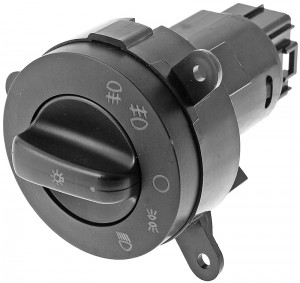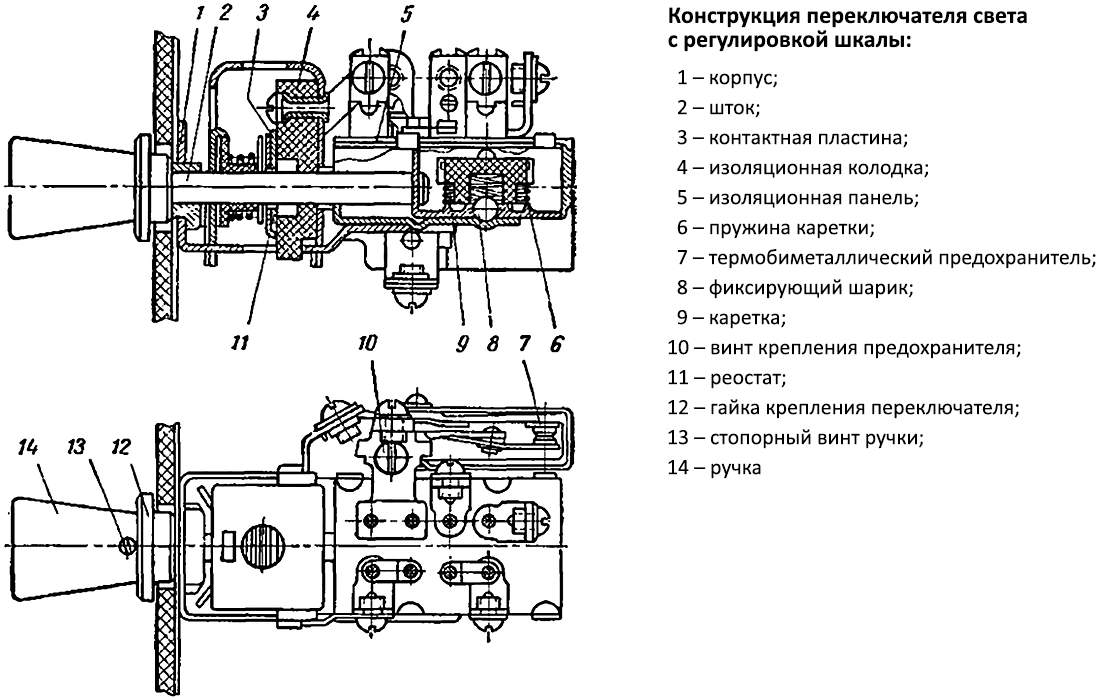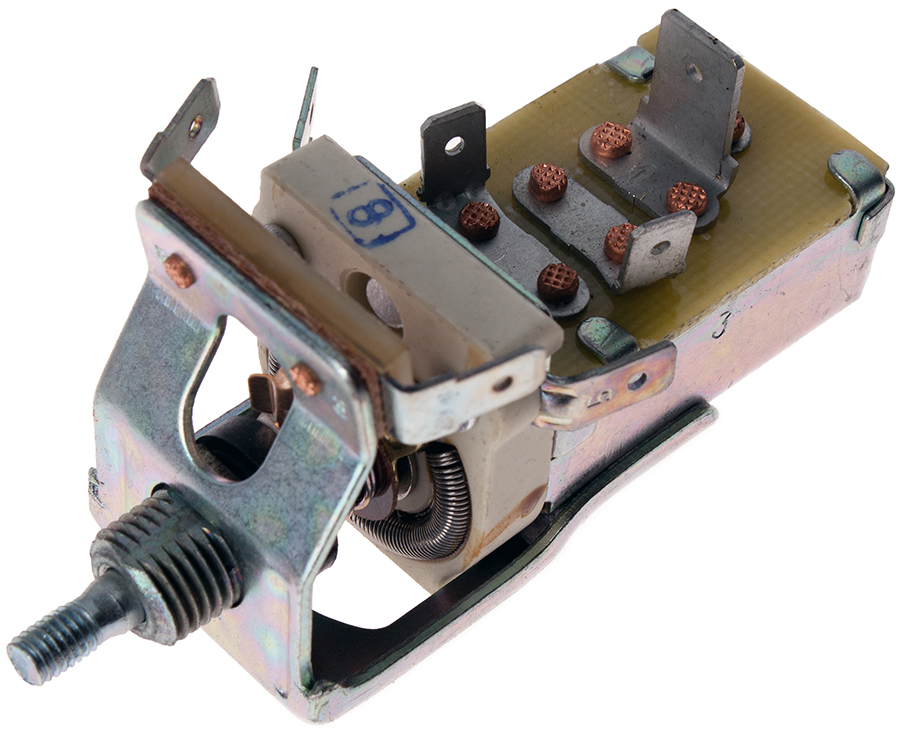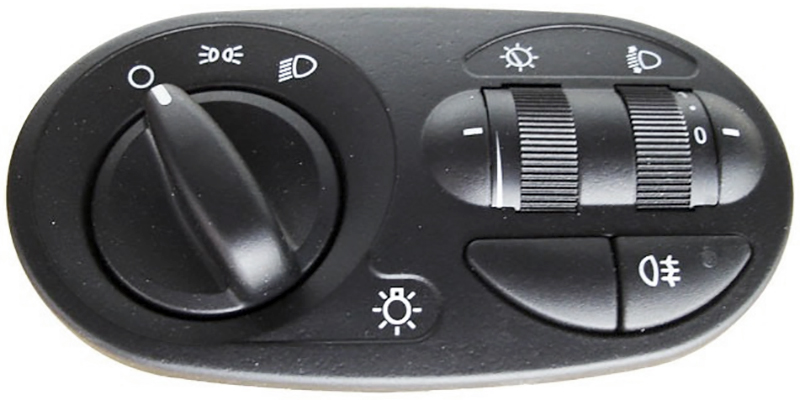
In many domestic cars of early releases, central light switches with a rheostat were widely used, allowing you to adjust the brightness of the instrument backlight. Read all about these devices, their existing types, design, operation, as well as their correct choice and replacement in the article
Purpose and functions of the light switch with scale adjustment
A light switch with scale adjustment (central light switch with a rheostat, CPS) is a switching device with a built-in rheostat, designed to turn on / off the external lighting devices of the vehicle, as well as to turn on and adjust the brightness of the instrument backlight.
For normal operation of the car, the driver needs to see the readings of the devices, regardless of the time of day and the degree of illumination. To this end, the scales of all instruments on the dashboard are illuminated using built-in lamps or LEDs. In many vehicles, the brightness of this backlight can be adjusted. In the domestic automotive industry, this function was often implemented using a combined switching device - a central light switch with backlight adjustment based on a built-in wire rheostat.
A light switch with scale adjustment is a device that has several functions:
● Switching of external lighting devices of the vehicle - headlights, parking lights, license plate illumination, fog lamps and lamps;
● Switching the backlight of the dashboard or instrument cluster;
● Adjusting the brightness of the dashboard light;
● In the presence of a thermobimetallic fuse - protection of electrical circuits of lighting devices from overloads in case of short circuits or other malfunctions.
That is, this device acts as a conventional CPS, providing switching circuits of external lighting devices of the car (while switching the operating modes of the headlights is carried out by a separate switch), and as a means of increasing comfort when driving a car by setting the optimal brightness of the instrument backlight. Any malfunctions of the light switch with backlight adjustment result in incorrect operation of lighting devices, in the event of such situations, the device must be repaired or replaced. But before you go to the store for a new CPS with a rheostat, you should understand the existing types of these devices and their features.
Types, design and features of light switches with scale adjustment
On domestic cars, several models of light switches with backlight brightness adjustment are used - P38, P44, P-306, P312, with indices 41.3709, 53.3709, 531.3709 and others. However, they all have a fundamentally identical device, differing only in dimensions and installation dimensions, the number of contact groups and some characteristics. It should also be noted here that similar switches are widely used on tractors, special and other equipment.
In general, the switch has the following design. The basis of the device is a case on which there are two switching nodes: a rheostat on an insulating block closed with a metal bracket (to protect against the ingress of foreign objects that can cause a short circuit), and the contact block itself with a fixed base on which the output terminals with screw clamps are located, and a movable carriage with contact bridges. In the lower part of the body under the carriage there is a simple latch based on a spring-loaded ball, which falls into the recess in the carriage, ensuring its fixed position. The carriage is rigidly connected to a metal rod, at the end of which there is a plastic handle that extends to the front of the dashboard.
The rheostat part of the switch is assembled on a ceramic insulating plate with a circular trough, in which there is a twisted nichrome wire - a rheostat. The stem is fitted with a plastic sleeve with a slider that can slide over the rheostat when the handle is turned. The sleeve with a slider is pressed against the rheostat by a spring. The rheostat is connected to the dashboard lighting circuit using two output terminals: one directly from the rheostat, the second from the slider.
Switches of types P-44 and P-306 have a built-in thermobimetallic fuse of repeated action, which disconnects all circuits of lighting devices in case of overloads or short circuits. The fuse is built on a thermobimetallic plate, which, when heated, bends due to the high current flowing through it, moves away from the contact and opens the circuit. When cooling, the plate returns to its original position, closing the circuit, but if the malfunction is not eliminated, it soon departs from the contact again. The fuse is made in the form of a separate block located on the side of the switch housing. The rest of the most popular switches are paired with a separate thermal bimetallic fuse.

Light switch design with scale adjustment

Light switch design with scale adjustment(central light switch)
The P-38 type switch has six output terminals, the rest are only five. One terminal always goes to the "ground", one - from the rheostat for connecting the dashboard light, the rest - for connecting outdoor lighting devices.
All the GQPs discussed here work in conjunction with additional headlight switches. In cars of early models, a foot switch was widely used, which ensures the inclusion of low and high beams. Later, the switches began to be installed on the dashboard and integrated into the paddle shifters. On current models, CPS with an integrated rheostat are practically not used to change the brightness of the backlight, most often the corresponding regulators are placed on the dashboard or combined into one unit with the CPS, and sometimes with the headlight position regulator.
Working Principle of Light Switch with Scale Adjustment
The CPS work with backlight adjustment as follows. With the help of the handle, the rod is pulled out of the housing and pulls the carriage with contact bridges, which, when the carriage is fixed, ensure the closure of the output terminals and, accordingly, the circuits associated with them. The handle has three positions:
● "0" - the lights are turned off (the handle is completely recessed);
● "I" - side lights and rear license plate illumination are turned on (the handle is extended to the first fixed position);
● "II" - the headlights are turned on together with all these devices (the handle is extended to the second fixed position).
In the "I" and "II" positions, you can also turn on the dashboard lights, for this the switch handle is rotated clockwise. When the handle is turned, the slider moves along the rheostat, which provides a change in the current strength in the backlight lamp circuit and, accordingly, an adjustment of their brightness. To turn off the backlight, the handle is rotated counterclockwise until it stops.
How to select, install and use the light switch with scale adjustment
Since the CPS with a rheostat is an electromechanical device, it often has malfunctions associated with mechanical wear - breakdowns and deformation of individual parts, contamination of contacts, etc. Also, the operation of the device may deteriorate due to drying or contamination of the lubricant, oxidation of parts, etc. Violation of the switch is expressed in the inability to turn on or off all or individual lighting devices, in the spontaneous shutdown of devices during vibrations, in obstructed movement or jamming of the handle. In all these cases, the switch should be checked and, if defective, repaired or replaced.

Central light switch with remote instrument backlight control
For verification (as well as for replacement), the device should be dismantled and removed from the dashboard, usually the switches are held with a single nut (however, the handle must also be removed for dismantling). It is necessary to make a visual inspection of the switch, clean the contacts and use a tester or a control lamp and a battery to check its contact groups for their normal operation.
If the faulty switch cannot be repaired, it should be replaced. For replacement, it is recommended to take a device of the same type and model that was installed on the car earlier. In some cases, it is allowed to use a device of a different model, but in some cases such a replacement will require refinement. For example, when installing the P-312 switch instead of the P-38, it will be necessary to change the wiring of the electrical circuits of lighting devices, which may affect the algorithm for turning them on and off.
Replacement and other work must be carried out in accordance with the repair instructions for this particular vehicle. If the selection and replacement of the light switch with backlight adjustment are performed correctly, then all internal and external lighting devices of the vehicle will work without interruption.
Post time: Jul-10-2023
